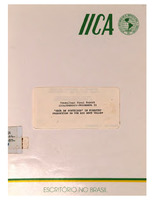| dc.contributor.author | Instituto Interamericano de Cooperación para la Agricultura (IICA) | es |
| dc.contributor.author | Kozlowsky, Theodore T. | es |
| dc.date.accessioned | 2020-11-18T21:06:01Z | |
| dc.date.available | 2020-11-18T21:06:01Z | |
| dc.date.issued | 1989 | |
| dc.identifier.issn | 0534-0591 | |
| dc.identifier.uri | https://repositorio.iica.int/handle/11324/13382 | |
| dc.description | 44 páginas. | es |
| dc.description.abstract | Seca is characterized by leaf browning and shedding near the top of the tree, preceded by development of lesions in leaf axils and branches of the upper crown. The lesions are invades by fungi which generally are weak pathogens or saprophytes. Whereas most species planted in the Rio Doce Valley are variously susceptible to Seca, Eucalyptus torreliana, E. camaldulensis, and E. tereticornis are variously resistant. E. citriodora es very susceptible to Seca but recovers rapidly, usually within 1.5 years after planting. Other susceptible species include E. grandis, E. pilularis, E. maculata, E. urophylla, E. saligna, and E. cloeziana. | es |
| dc.language.iso | en | es |
| dc.publisher | Instituto Interamericano de Cooperación para la Agricultura (IICA) | es |
| dc.subject | Enfermedades fungosas||fungal diseases||doença fúngica||maladie fongique | es |
| dc.subject | Lesiones||lesions||lesão||lésion | es |
| dc.subject | Eucalyptus torrealiana | es |
| dc.subject | Desarrollo forestal||forestry development||desenvolvimento florestal||développement forestier | es |
| dc.subject.other | Representación Brasil | es |
| dc.title | Seca de ponteiros in forestry production in the Rio Doce Valley | es |
| dc.type | Consultoría | es |


